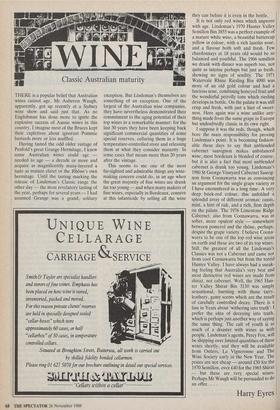Classic Australian maturity
THERE is a popular belief that Australian wines cannot age. Mr Auberon Waugh, apparently, got up recently at a Sydney wine show and said just that. As no Englishman has done more to ignite the explosive success of Aussie wines in this country, I imagine most of the Bruces kept their expletives about ignorant Pommie bastards more or less muffled.
Having tasted the odd older vintage of Penfold's great Grange Hermitage, I knew some Australian wines could age needed to age — a decade or more and acquire as magnificently many-layered a taste as mature claret or the Rhone's own hermitage. Until the tasting marking the release of Lindeman's Classic range the other day — the most revelatory tasting of the year, perhaps for several years — I had assumed Grange was a grand, solitary exception. But Lindeman's themselves are something of an exception. One of the largest of the Australian wine companies, they have nevertheless demonstrated their commitment to the aging potential of their top wines in a remarkable manner: for the last 30 years they have been keeping back significant commercial quantities of some special reserves, cellaring them in a huge temperature-controlled store and releasing them at what they consider maturity. In some cases that means more than 20 years after the vintage.
This seems to me one of the most far-sighted and admirable things any wine- making concern could do, in an age when the great majority of fine wines are drunk far too young — and when many makers of fine wines, especially in Bordeaux, connive at this infanticide by selling all the wine they can before it is even in the bottle.
It is not only red wines which improve with age. Lindeman's 1970 Hunter Valley Semillon Bin 3855 was a perfect example of a mature white wine, a beautiful buttercup yellow in colour, with a rich lanolin nose, and a flavour both soft and fresh. Few chardonnays at 18 years old would be so balanced and youthful. The 1966 semillon we drank with dinner was superb too, not quite as intense perhaps but just as fresh, showing no signs of senility. The 1971 Watervale Rhine Riesling Bin 4090 was more of an old gold colour and had a luscious nose, combining honeyed fruit and the wonderful petrolly tone which riesling develops in bottle. On the palate it was still crisp and fresh, with just a hint of sweet- ness. Here again was a wine unlike any- thing made from the same grape in Europe but undoubtedly classic in its own right.
I suppose it was the reds, though, which bore the main responsibility for proving Lindeman's point. It is becoming fashion- able these days to say that unblended cabernet sauvignon makes unbalanced wine; most Bordeaux is blended of course, brit it is also a fact that most unblended cabernet is drunk too young. Lindeman's 1980 St George Vineyard Cabernet Sauvig- non from Coonawarra was as convincing an argument for the single grape variety as I have encountered in a long time. A very deep brick-red colour, this unfolded a splendid array of different aromas: cassis, mint, a hint of oak, and a rich, firm depth on the palate. The 1976 Limestone Ridge Cabernet, also from Coonawarra, was in softer, more opulent style — sOmewhere between pomerol and the rhone; perhaps, despite the grape variety. I believe Coona- warra to be one of the top red wine areas on earth and these are two of its top wines. Still, the greatest of all the Lindeman's Classics was not a Cabernet and came not from cool Coonawarra but from the torrid Hunter Valley. I have always had a sneak- ing feeling that Australia's very best and most distinctive red wines are made from shiraZ, not cabernet. Well, the 1965 Hun- ter Valley Shiraz Bin 3110 was simply sensational, bursting with those tarry, leathery, gamy scents which are the result of carefully controlled decay. There is a line in Yeats about 'withering into truth': I prefer the idea of decaying into truth, which is perhaps just another way of saying the same thing. The cult of youth is as much of a disaster with wines as with people. Lindeman's agents, Percy Fox, will be shipping over limited quantities of these wines shortly, and they will be available from Ostlers, La Vigneronne and The Wine Society early in the New Year. The prices are not cheap — around £30 for the 1970 Semillon, over £40 for the 1965 Shiraz — but these are very special wines. Perhaps Mr Waugh will be persuaded to do an offer. . .
Harry Eyres










































































 Previous page
Previous page